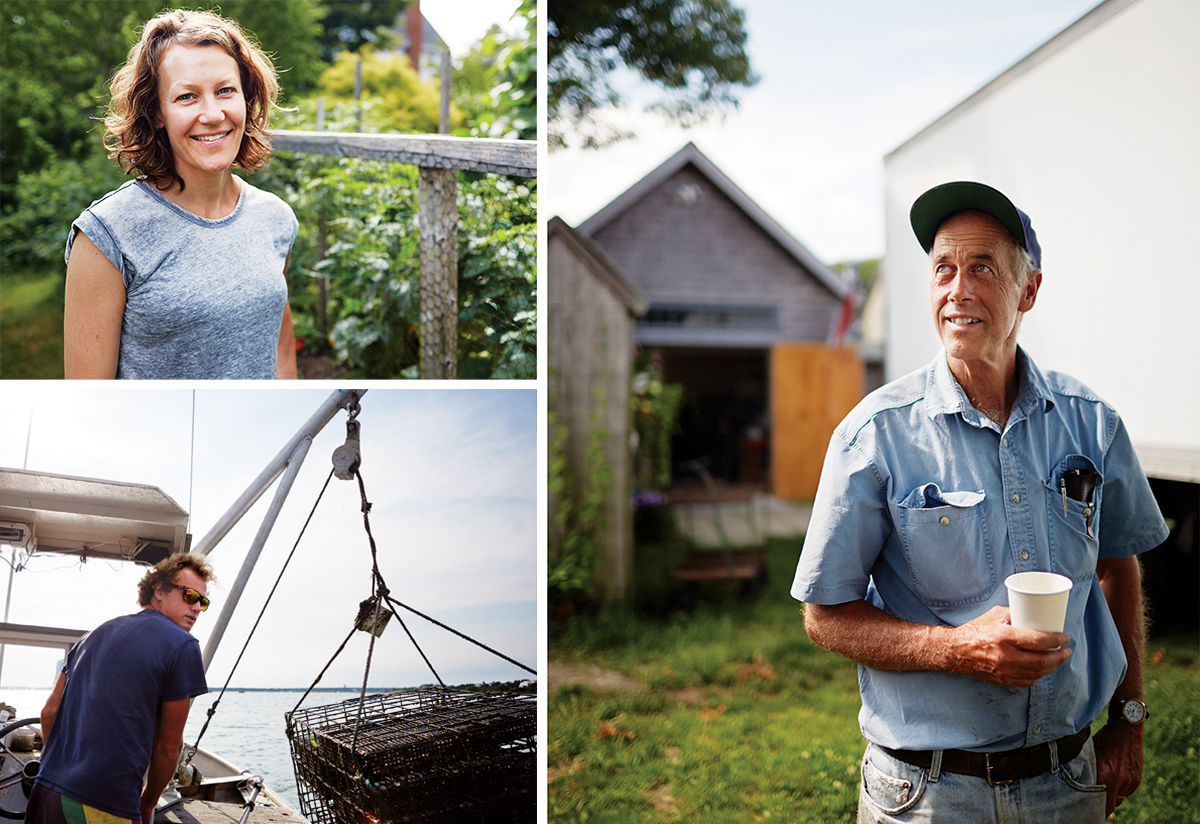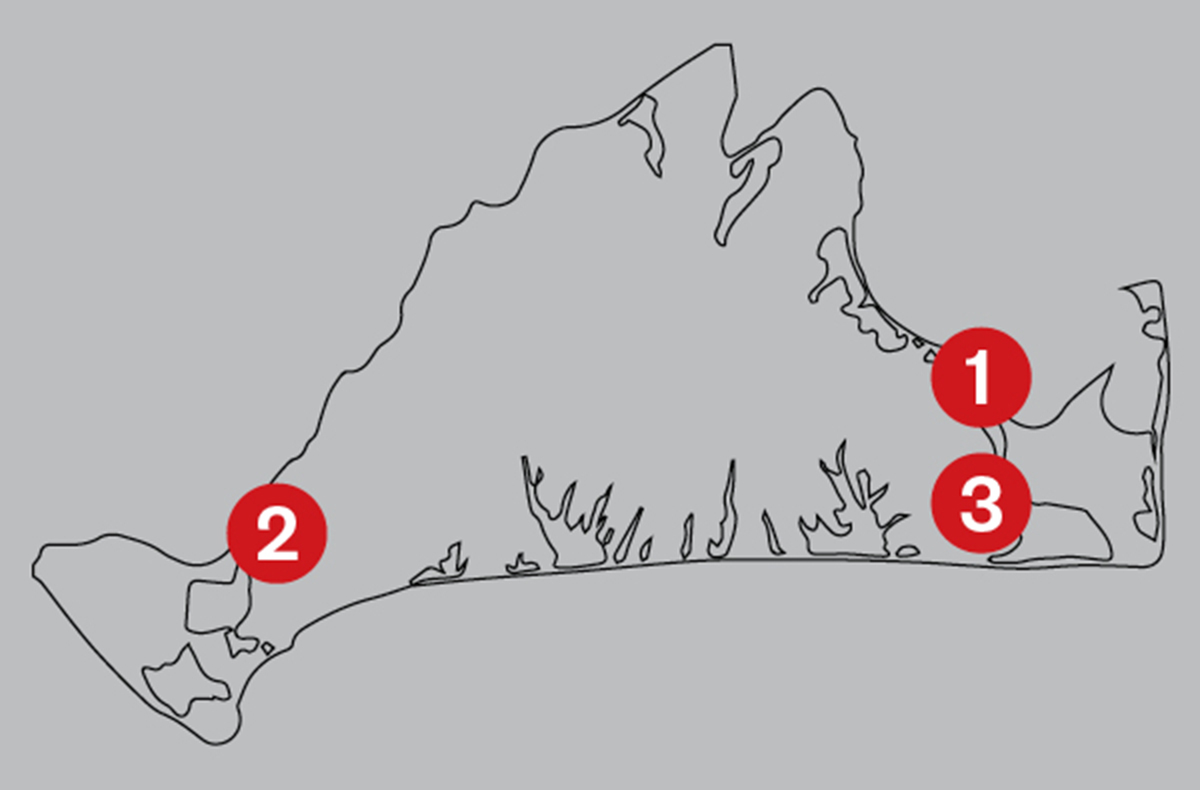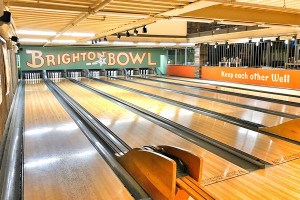Bring on Summer
For the farm-to-table aficionado…
Gourmet Foraging on Martha’s Vineyard
By Janelle Nanos

The cast of characters on a Farm.Field.Sea. excursion includes founder Nevette Previd (top left); Morning Glory Farm’s Jim Athearn (right); and Honeysuckle Oyster Farm’s Nic Turner (bottom left). | Photographs by Jonathan Kozowyk
It’s a pristine Saturday morning out on Katama Bay, and the glassine water hardly ripples as our boat glides through the harbor. I’m sitting on a dinghy owned by Nic Turner, the 30-year-old proprietor of Honeysuckle Oyster Farm, heading out to see his farm. It’s one of a dozen hatcheries now thriving in the waters around Martha’s Vineyard, and just the first stop on my journey through the island’s culinary landscape.
From State Road to the Beach Plum Inn, the Vineyard has no shortage of gastronomic gems, and as a slightly food-obsessed travel writer, I’ve enjoyed most of them. But after countless visits over the past four years, I found myself yearning for something more—a deeper connection to the fresh seafood and vine-ripened tomatoes on my plate. Farm.Field.Sea., a tour company run by former New York City film marketer Nevette Previd, offered just the remedy: a day of foraging through the Vineyard’s fertile land and waters. Yes, foraging: For the past two summers, she’s introduced small groups to the island’s growers and chefs and arranged hands-on visits to local farms.
Which is how I found myself slicing through Katama Bay, listening as Turner fills us in on his seafaring background. Born into a family of fishermen—his father catches conch, and considers himself one of the oldest surfers on the bay—Turner started his own oyster farm in 2011, at just 26 years old. As he navigates toward his hatchery, decked out in orange waders, he gives us a tutorial in aquaculture. Each of the 12 farmers on the bay has an acre of water to grow crops; the largest operation can harvest more than a million oysters over the course of a year. Each oyster Turner raises can filter up to 50 gallons of water a day, which helps keep the bay clean.
I hop off the boat onto the hatchery, a floating 12-by-20 platform attached to another platform beside it. That’s where Turner keeps the two tools that allow him to determine which oysters are ready to sell: the sorter, which separates them by size, and the tumbler, a spinning mesh cage that regularly agitates away any algae growing on the bivalves. Turner pulls a handful out of the basket to reveal a brown, mossy coating, but after a few rounds through the tumbler, the shells come out clean.
After sailing back to the edge of the bay, we huddle with two of the island’s aquaculture experts: Rick Karney, of the MV Shellfish Group, and Paul Bagnall, Edgartown’s shellfish constable. Karney is talking about his group’s efforts to seed the waters around the island with shellfish in an effort to keep the harbor clean and the fishing industry thriving, but I find myself distracted by the buckets of quahogs, scallops, and mussels just plucked from the shoreline. Also grabbing my attention is the elaborate breakfast spread from Morning Glory Farm that sits on the table beside us: carrot-spiked muffins, breads, jam, granola, yogurt, and fresh fruit. It’s just a taste of what’s to come, as we’re headed there next.

Photographs by Jonathan Kozowyk
It’s been 40 years since Jim and Debbie Athearn first decided to put down roots—literally—in Martha’s Vineyard. Now their 60-acre farm is so famous that their sweet corn occasionally sells out within seconds of arriving at the stand. Today, our tour group is helping out on the farm, and Jim and his son Simon are more than happy to walk us through the paces. We plant cucumbers and pull off dead stems from the jungle of tomato plants growing in the greenhouses. Inside Morning Glory’s kitchen, we prep parsley for pesto and wash carrots, then join chef Robert Lionette as he breaks down entire trays of freshly roasted chicken to prepare rillettes for our lunch in the greenhouse.
After scrubbing the dirt from beneath my fingernails, I reconvene with Previd and our tour guides on the patio at the Noepe Center for Literary Arts for supper. While sipping cocktails and local beers, we mingle with guests who’ve only signed up for the dinner portion of the evening and boast that we’re in good with the farmers. Then, at last, it’s time to take a seat at the long dining table and dig into a meal showcasing the Vineyard’s bounty. I’m convinced it tastes better than any other I’ve had on the island. Maybe that’s because I had a hand in making it.

DON’T MISS
EAT: You can find oyster farmer Nic Turner’s Honeysuckle oysters on the menu at [1] Henry’s Hotel Bar at the Harbor View Hotel (131 N. Water St., Edgartown, harbor-view.com/dining/henrys).
STAY: At the 13-room [2] Beach Plum Inn (50 Beach Plum Ln., Menemsha, beachpluminn.com), guests can gather eggs from the inn’s chickens, stroll down to the beach, and sip cocktails at one of the island’s best sunset-viewing spots.
SEE: Learn about wild edibles, tour a local oyster farm, or join Vineyard chefs, farmers, and food
activists for an evening meal that showcases the island’s farm-to-table ethos with Farm.Field.Sea. (ffsmv.com). Or stop by the [3] Farm Institute (14 Aero Ave., Edgartown, farminstitute.org) to tour a working island farm or enjoy an outdoor family movie night. —J.R.
Nantucket | Martha’s Vineyard | Wellfleet | Provincetown | Our Summer Vacation


